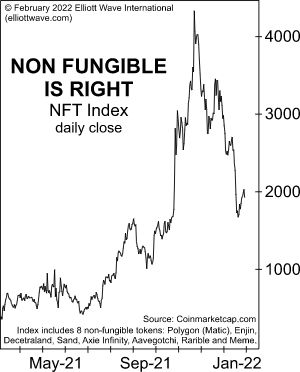Non-Fungible Tokens (NFTs): A Replay of Holland’s “Tulip Mania”?
The NFT Index is down more than 55% from its November high.
It seems the financial world has gone a little crazy — maybe a lot crazy.
Specifically, I’m talking about non-fungible tokens or NFTs for short. You may be familiar with them, but in case you’re not, here’s a description (CNN Business):
In the simplest terms, NFTs transform digital works of art and other collectibles into one-of-a-kind, verifiable assets that are easy to trade on the blockchain.
So, yes, non-fungible tokens are generally encoded with the same software as many cryptos and a key feature is digital scarcity.
Put another way, NFTs are like physical collector’s items, only digital.
As examples, Twitter founder Jack Dorsey’s first tweet sold for $2.9 million and a video clip of a LeBron James slam dunk sold for over $200,000. One that really took the cake was a collage of images by digital artist Beeple, which sold for a staggering $69.3 million. There have been many other very high-priced NFTs.
Indeed, here’s a March 10 CNBC headline:
Trading in NFTs spiked 21,000% to more than $17 billion in 2021…
Previous generations of investors would likely have thought it insane to pay nearly $70 million for “digital art” — a piece that the owner could not touch or hang on a wall, and one that could be easily copied by pressing two buttons on any keyboard — yet that’s the extent to which investing products have changed.
However, one thing that hasn’t changed is the investor psychology which drives investing.
A Feb. 15 Forbes article which discusses non-fungible tokens says:
These digital assets are selling like 17th-century exotic Dutch tulips.
Well, those familiar with financial history know that Tulip Mania did not end well. Tulips went from 20 cents to 60 florens and then crashed to 2 cents — very fast.
With that in mind, is an NFT crash already underway?
Here’s a chart and commentary from the February Global Market Perspective, a monthly publication which provides analysis of 50-plus worldwide financial markets:

This chart shows a cross section of NFTs selected by Coinmarketcap.com to represent the performance of the NFT market. The index is down more than 55% from its November 24 high.
As of this writing on March 16, the NFT Index is trading even lower than it was at the time the February Global Market Perspective published.
It’s possible that this NFT Index could bounce back and reach new highs. But would it be wise to bet on it?
Right now, the financial world is also exhibiting a “tulip mania” mindset in other sectors beyond NFTs.
Prepare now for what the Elliott wave model suggests is just ahead for cryptocurrencies, global stock markets, crude oil, forex, bonds and metals.
If you need to freshen up on your knowledge of the Elliott wave model, or are new to the subject, you are encouraged to read Frost & Prechter’s Elliott Wave Principle: Key to Market Behavior. Here’s a quote from the Wall Street classic:
Without Elliott, there appear to be an infinite number of possibilities for market action. What the Wave Principle provides is a means of first limiting the possibilities and then ordering the relative probabilities of possible future market paths. Elliott’s highly specific rules reduce the number of valid alternatives to a minimum. Among those, the best interpretation, sometimes called the “preferred count,” is the one that satisfies the largest number of guidelines. Other interpretations are ordered accordingly.
You can delve into the details of the “high specific rules” of the Elliott wave model by reading the online version of Elliott Wave Principle: Key to Market Behavior for free.
All that’s required for free access is a Club EWI membership. Club EWI is the world’s largest Elliott wave educational community and is free to join. Members enjoy free access to a wealth of Elliott wave resources on financial markets, investing and trading without any obligation.
You can get started by following this link: Elliott Wave Principle: Key to Market Behavior — free and unlimited access now.